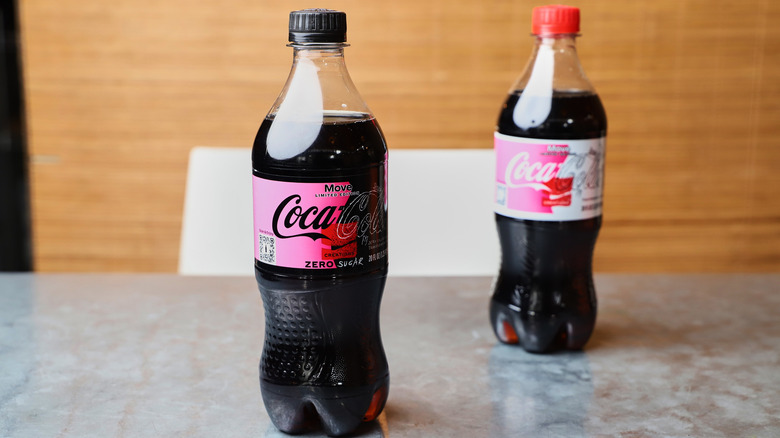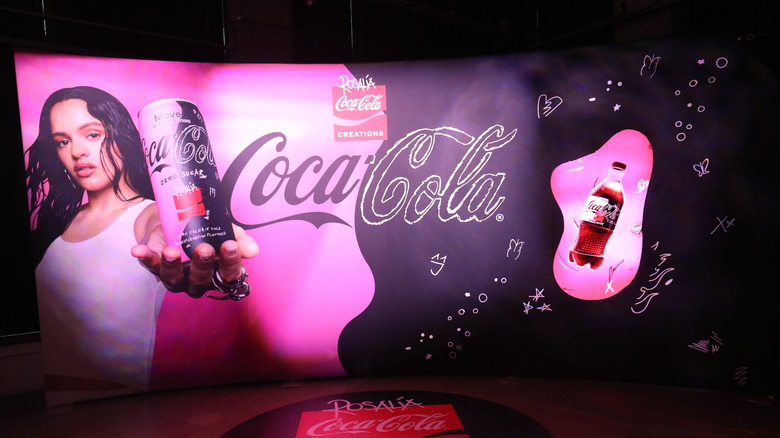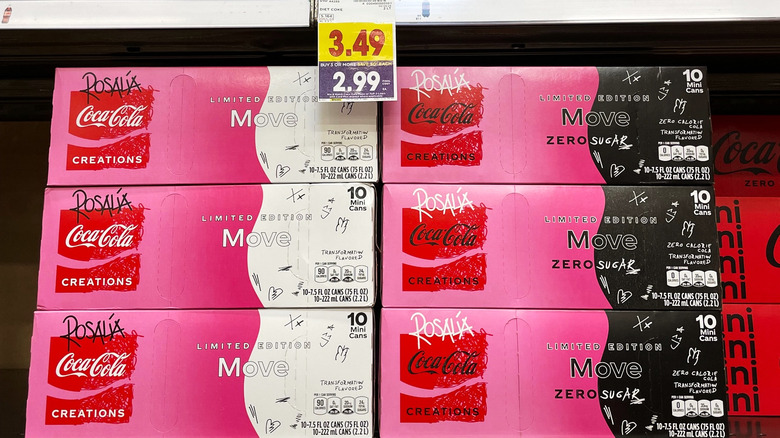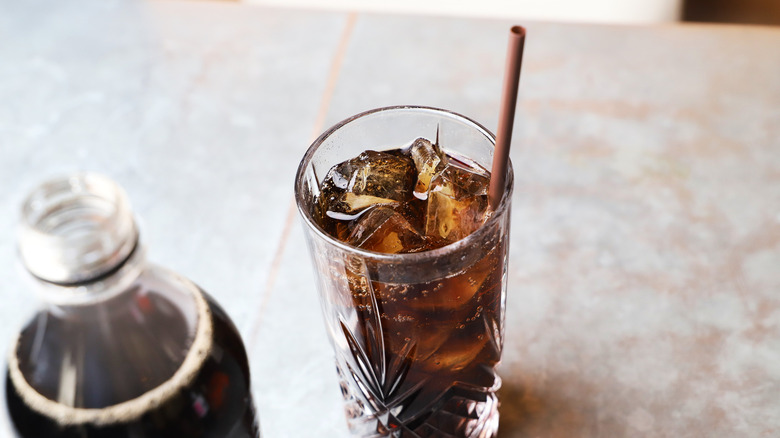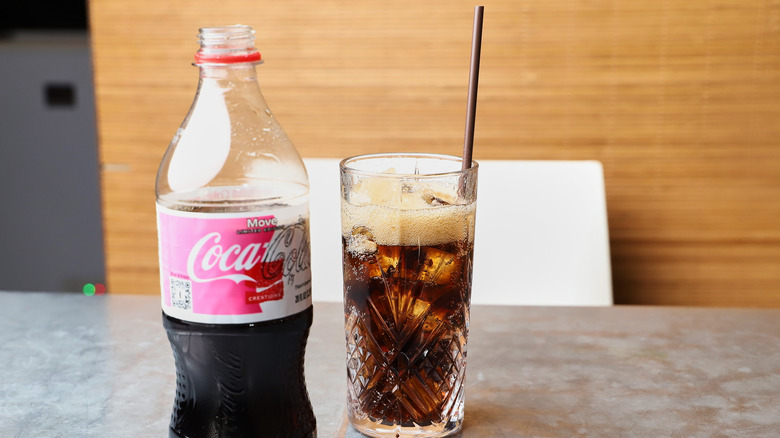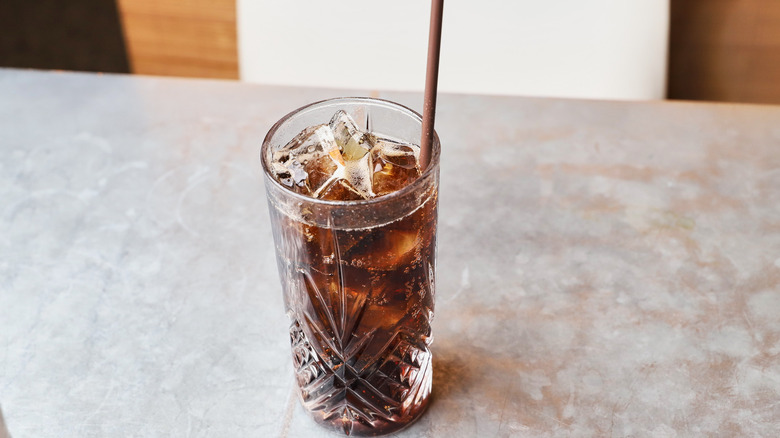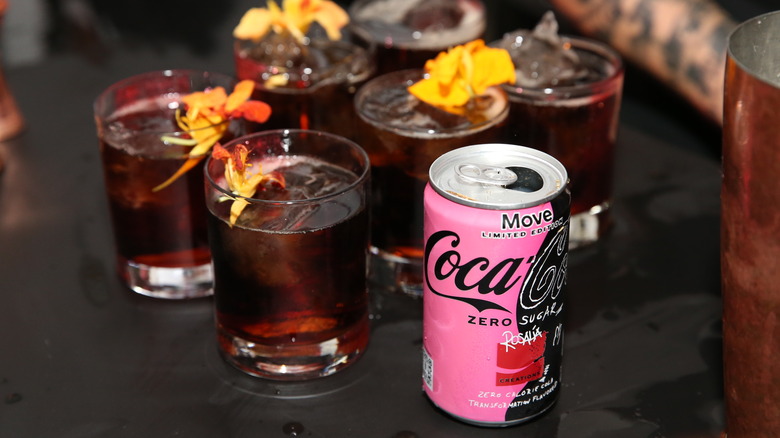We Tried The New Coke 'Transformation' Flavor So You Don't Have To
Legacy brands like Oreo and Baskin-Robbins devote substantial marketing dollars to developing and debuting innovative flavors and co-brandings with hopes of remaining relevant, newsworthy, and fresh. And Coca-Cola, America's leading soda brand, is no different; after enjoying revenue of more than $43 billion dollars in 2022 (partially thanks to increased prices), the popular soda brand continues to inaugurate new flavors to keep the brand current.
Following 2022's Gen Z-bent Dreamworld, Coca-Cola ushered in 2023 with last month's transformation-inspired flavor, a Fuschia-branded collaboration with Grammy winner Rosalía. Hoping to capture the performing artist's aesthetic, the new beverage also boasts the title "Move." At first glance, the bottle looks similar to Cherry Coke, but upon closer inspection, the soft pink label reveals its connectedness to Rosalía and the soda's unique theme. Priced similarly to Coke's regular line-up, Move will run you about $2 for a 12-ounce bottle, or around $7.50 for a case of mini 10-ounce cans. While its website or press releases don't explicitly state how long Move might be stocked at your local grocery and convenience stores, the Coca-Cola website lists it under its limited edition "Creations" line along with Dreamworld, Marshmello, and Starlight, all of which debuted last year, so it's safe to bet Move will stay put at least until 2024.
Who is Rosalía?
Move and its co-creator, Rosalía, might be as new as the pink bottle itself for anyone not tuned into the latest pop culture news. The Spanish-born musical phenom rose to international fame with the release of her album "Motomami" in 2021. Later the following year, she won a Grammy for Best Latin Rock or Alternative Record.
Released in conjunction with Rosalía's latest single, "Lie Like You Love Me," Coca-Cola now appears to be wading into the realm of content creators and influencers to drive business among young, potential soda drinkers.
Like its other limited-edition release, Marshmello — where the brand teamed up with the white-masked DJ — Coke's Move partnership with Rosalía capitalizes on the current moment. The company is prioritizing working in concert with an artist of considerable relevance, but one who is less widely recognized as the more notable artists fast food companies like McDonald's (BTS, among others) and Popeye's (Megan Thee Stallion) have developed limited-edition meals and sauces with.
What is it?
Unlike when it followed food trends with 2005's Coke with Lime, 2017's Coke with Raspberry, or the coffee-laden and entirely misguided Coke Black of the late '00s, Coca-Cola's collaboration with Rosalía banks more on the pop star's appeal than explicitly stating a new flavor profile. The bottles themselves (in both a 240-calorie and a zero-sugar version) claim to be "transformation flavored" and omit any further details regarding taste, so we took home the latest Coca-Cola creation to test drive the soda giant's newest contribution to its growing canon.
While the Coca-Cola website openly describes Marshmello's flavor as "strawberry and watermelon," Move is only explained as "great, but familiar Coca-Cola tastes with bold and delicate flavors," which doesn't exactly tell us much.
The latest lineup of limited edition flavors boasts a more ethereal and vibey motif than the open amendments in the flavor of their recent past. Coca-Cola Starlight claims to be "inspired by space," the company's Zero Sugar Byte alleges to be "borne in the metaverse," and Dreamworld declares the baby-blue cans to be "dream flavored." Inside the lineup of flavors from the past year, Move makes sense within the direction of their current offerings — consistently convoluted while stoking the flames of curiosity just enough to inspire an impulse purchase.
Nutritional facts
Like Coca-Cola Classic, a 20-ounce bottle of Coca-Cola Move contains 240 calories and 65 grams of sugar — translating into a whopping 16 teaspoons (or ⅓ of a cup) of sugar. But unlike Coke Classic, Diet Coke, and Coke Zero, Move isn't offered in a traditional 12-ounce aluminum can but only in the aforementioned 20-ounce plastic bottle. The more reasonably portioned 7.5-ounce mini cans, only contain 90 calories and 24 grams of sugar (about the recommended daily sugar intake, according to Healthline).
However, like its other limited edition flavors, Move has a zero-calorie alternative to the sugar-packed original. With no sugar and no calories, the soda relies on ingredients like acesulfame and aspartame to achieve a sweet-seeming flavor without including real sugar. But like Coke's other diet offerings, the health benefits of picking up a can of Move Zero are murky and based on personal preference.
What does it taste like?
The first notable distinction between Coke Classic and Coca-Cola Move (as far as we can tell, all of Coca-Cola's offshoot flavors don the same deep, caramel, brown color as the original soda) is the new flavor's boldly spiced, tobacco-y, nose. Smelling more akin to an oaky red wine like a Rioja than a soft drink, Move seems to strive for an adult flavor profile and veers away from overtly fruity or sweet smackings.
The spiciness renders the soda into feeling thick on the tongue and not exactly refreshing. The beverage reminds us of burnt popcorn, a cigar box, and wine we imagine boomer parents being enthusiastic over. While we didn't find the soda solely unpleasant at first sip, we're also confused by how niche but not necessarily on-trend Move seems. We expected something bright and exuberant like Rosalía's music and stage presence — perhaps with a smacking of something tart like passionfruit. But what we got instead was a melancholy, slow, almost savory flavor we'd expect an artist like Kasey Musgraves to be behind.
How does it stack up?
What's difficult for a brand as unambiguous as Coca-Cola is finding a corner of the market that both likes Classic Coca-Cola and is open to variations of a universally recognized flavor. When compared to stalwarts like Cherry Coke and Vanilla Coke, Move hovers somewhere near Vanilla Coke's underwhelming pointlessness and never comes close to the heights of Cherry Coke's exceptional flavor profile. Invented in 1985, Cherry Coke has survived nearly four decades of Coca-Cola's metamorphoses while fleeting fruit flavors like Coke Lemon, Coke Lime, Coke Black Cherry Vanilla, and Coke Raspberry all fell victim to the tides of food trends.
As far as diet options, Move Zero Sugar sits near the dullness of Coke Zero and can't approach Diet Coke's iconic taste. However, Move Zero Sugar translates the peculiar flavor of the full-calorie version of Move without compromising the dense taste of the original, but (like most diet sodas) the finish is flat, dull, and a little uncanny.
Is it worth buying?
Whether or not we'd reach for another bottle of Move almost misses the point; Coca-Cola realizes the sustainability in stoking consumer's curiosity by continually releasing temporal, intangible flavors reliant on the experience of actually sampling the release themselves. With its limited edition creations, Coca-Cola has calculated a perfect equation of bringing enough weirdness to its otherwise predictable catalog with a handful of offerings an interested consumer can't immediately write off if they don't like vanilla, cherry, raspberry, lemon, lime, or any other clearly-defined flavor devices.
We thoroughly disliked Coca-Cola Move. In fact, we had to reseal our bottle because the aroma emanating from its mouth was so severe our living room started to smell like a dusty vape pen. But had we not tested Move out for ourselves, we would have never known the strange zone Cola-Cola has been drifting into. So while we won't be stocking our fridge full of Rosalía's first foray into the beverage world before Coke discontinues the oddity, we will be paying more attention to the transitory flavors the soda giant no doubt will continue to release.
